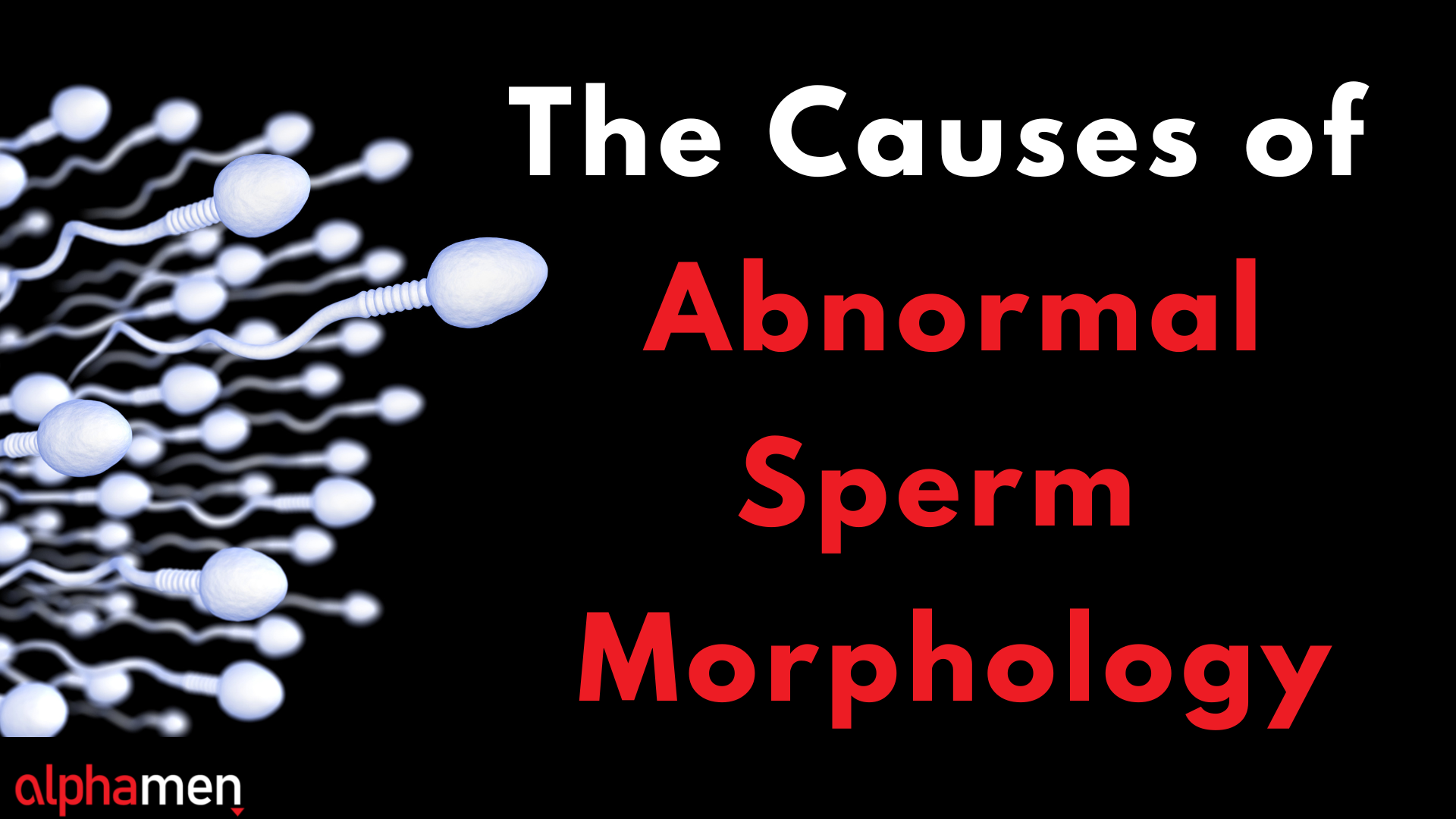Sperm morphology is the study of the physical form and structure of sperm. This includes the size, shape and appearance of the sperm head, neck and tail. Abnormal sperm morphology is when there are abnormalities in one or more of these areas. This can be caused by many different factors such as genetics, lifestyle choices, environmental pollutants and more.
1. What is sperm morphology and what does it involve?
Sperm morphology is important because it can affect a man’s ability to father a child. Abnormal sperm morphology can cause fertility problems and make it difficult for a man to conceive. There are many different causes of abnormal sperm morphology, and it can be difficult to determine the cause in some cases. However, there are treatments available for men who have fertility problems caused by abnormal sperm morphology. We’ll talk about them a little bit below…
2. What are the causes of abnormal sperm morphology?
Before answering this question, let’s first understand normal sperm morphology and abnormal sperm morphology!

Normal sperm morphology
Most sperm have:
- The sperm head is an oval-shaped structure that’s about 5–6 micrometers long and 2.5 – 3 inch wide with a well defined cap called “acrosome” which covers 40 – 70% on its length for fertilization purposes.
- The sperm is a complex organ that must perform its function with perfection.
- It has two main components: the head, which contains mitochondria and serves to power it; as well at least one tail made up protein fibers called “serpents.” The serpents help guide movement towards eggs while also providing some protection for lengthwise collisions against other cells in order reduce wear-and tear on delicate parts like necks or tails (which can sometimes be abnormal).
Abnormal sperm morphology
Common abnormalities of sperm that make fertilization more difficult include:
- Sperm with an unusually large head
- Pipless or double-headed sperm
- missing tails or multiple tails
- Sperm with abnormal tails, such as bent or coiled
- Misshapen sperm heads
- Abnormally small or large sperm
The most common causes of abnormal sperm morphology are genetic defects, lifestyle factors (such as smoking and alcohol consumption), environmental pollutants and some medical conditions.

There are many different causes of abnormal sperm morphology, and it can be difficult to determine the cause in some cases. However, there are treatments available for men who have fertility problems caused by abnormal sperm morphology.
Some common causes of abnormal sperm morphology include:
– Genetics: Some men are born with abnormalities in their sperm morphology. This is something that cannot be changed and may require treatment if it affects fertility.
– Lifestyle choices: Smoking, drinking alcohol and using drugs can all affect the quality of a man’s sperm and can lead to abnormalities in sperm morphology.
– Environmental pollutants: Chemicals and pollutants in the environment can also affect the quality of a man’s sperm and lead to abnormalities in sperm morphology.
– Age: As men get older, their sperm may start to show signs of age-related changes, which can lead to abnormalities in sperm morphology.
3. How is abnormal sperm morphology diagnosed?
Sperm morphology is diagnosed through a semen analysis, which is a test that examines the quality and quantity of a man’s sperm. A semen analysis can determine if there are any abnormalities in the size, shape or appearance of a man’s sperm. If abnormalities are found, a man may need to undergo additional testing to determine the cause.
The semen analysis is usually done in a lab and takes about 30 minutes. To prepare for the test, a man should abstain from sexual activity for at least three days before the test.
4. What are the treatments for abnormal sperm morphology?
No matter what treatment is chosen, it is important to remember that the success of fertility treatments depends on a number of different factors including age, lifestyle, and medical history. It is also important to note that some abnormalities in sperm morphology are not treatable and that some men may need to consider other options such as adoption or surrogacy.
If you have any questions or concerns about abnormal sperm morphology, it is important to speak with your doctor. Your doctor will be able to provide more information and advice based on your individual situation.
5. Are there any risks associated with treatment?
There are a number of risks associated with treatment for abnormal sperm morphology. Some common risks include:
– Medication side effects: Many medications used to treat abnormal sperm morphology have side effects that can range from mild to serious. It is important to discuss all potential side effects with your doctor before starting treatment.
– Surgery risks: any surgery carries the risk of complications, including infection and bleeding. It is important to discuss the risks and benefits of surgery with your doctor before deciding if it is right for you.
– Artificial insemination risks: There is a small risk of contracting sexually transmitted infections (STIs) through artificial insemination. It is important to use condoms and other forms of contraception during treatment to reduce the risk of STIs.
– IVF risks: IVF is a complex and expensive procedure, and there is a small risk of complications such as ectopic pregnancy. It is important to discuss the risks and benefits of IVF with your doctor before deciding if it is right for you.
Overall, it is important to speak with your doctor about the risks and benefits of any fertility treatment before making a decision. With the right information and support, it is possible to make an informed decision about the best course of action for your specific situation.
6. What is the prognosis for men with abnormal sperm morphology?
The prognosis for men with abnormal sperm morphology varies depending on the cause of the abnormalities. In some cases, the abnormalities can be treated and the man can go on to father children. In other cases, the abnormalities are not treatable and the man may need to consider other options such as adoption or surrogacy. It is important to speak with your doctor about the prognosis for your specific situation.
In general, the prognosis for men with abnormal sperm morphology is better when treatment is started early and when lifestyle changes are made to improve fertility.
Making healthy lifestyle choices such as eating a balanced diet, exercising regularly, and avoiding exposure to environmental pollutants can help to improve overall health and fertility. Additionally, avoiding smoking and excessive alcohol consumption can help to reduce the risk of fertility problems.
7. How can you improve your chances of having normal sperm morphology?
There are a number of things you can do to improve your chances of having normal sperm morphology. Some simple steps include:
– Eating a balanced diet: A balanced diet is important for overall health and fertility. Eating plenty of fruits and vegetables, and avoiding processed foods and sugary drinks, can help to improve sperm quality.
– Exercising regularly: Exercise is also important for overall health and fertility. Exercise can help to reduce stress levels, improve blood flow, and reduce the risk of obesity. All of these factors can improve sperm quality.
– Avoiding environmental pollutants: Environmental pollutants can negatively affect sperm quality. It is important to avoid exposure to pollutants such as cigarette smoke, exhaust fumes, and pesticides.
– Quitting smoking: Smoking cigarettes can have a negative impact on sperm quality. Quitting smoking can improve overall health and fertility.
– Limiting alcohol consumption: Alcohol consumption can also have a negative impact on sperm quality. Limiting alcohol intake can help to improve overall health and fertility.
Making healthy lifestyle choices is important for overall health and fertility. If you are trying to conceive, it is important to make sure you are doing everything you can to improve your chances of success. Speaking with your doctor can help you to identify any areas that need improvement and develop a plan for improving your sperm morphology.
8. Where can you find more information about sperm morphology?

Sperm morphology is the study of the physical form and structure of sperm. This includes the size, shape and appearance of the sperm head, neck and tail. Abnormal sperm morphology is when there are abnormalities in one or more of these areas. This can be caused by many different factors such as genetics, lifestyle choices, environmental pollutants and more.
There are a number of things you can do to improve your chances of having normal sperm morphology. Some simple steps include: eating a balanced diet, exercising regularly, and avoiding exposure to environmental pollutants.
Additionally, quitting smoking and limiting alcohol consumption can help to improve sperm quality. Making healthy lifestyle choices is important for overall health and fertility. If you are trying to conceive, it is important to make sure you are doing everything you can to improve your chances of success.
Conclusion
Sperm morphology is the study of the physical form and structure of sperm. This includes the size, shape and appearance of the sperm head, neck and tail. Abnormal sperm morphology is when there are abnormalities in one or more of these areas. This can be caused by many different factors such as genetics, lifestyle choices, environmental pollutants and more.
There are a number of things you can do to improve your chances of having normal sperm morphology. Some simple steps include: eating a balanced diet, exercising regularly, and avoiding exposure to environmental pollutants. Additionally, quitting smoking and limiting alcohol consumption can help to improve sperm quality.
Making healthy lifestyle choices is important for overall health and fertility. If you are trying to conceive, it is important to make sure you are doing everything you can to improve your chances of success.


